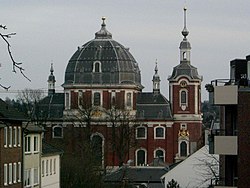This article includes a list of references, related reading, or external links, but its sources remain unclear because it lacks inline citations. (July 2021) |
You can help expand this article with text translated from the corresponding article in German. (February 2011) Click [show] for important translation instructions.
|
Burtscheid Abbey (German: Abtei Burtscheid) was a Benedictine monastery, after 1220 a Cistercian nunnery, located at Burtscheid, near Aachen, North Rhine-Westphalia, in Germany.
Imperial Abbey of Burtscheid Abtei Burtscheid | |||||||
|---|---|---|---|---|---|---|---|
| 1138–1802 | |||||||
 Burtscheid Abbey church | |||||||
| Status | Imperial Abbey | ||||||
| Capital | Burtscheid Abbey | ||||||
| Common languages | Moselle Franconian | ||||||
| Government | Theocracy | ||||||
| Historical era | Middle Ages | ||||||
• Founded by Benedictines | 997 | ||||||
• Made Reichsfrei | 1138 | ||||||
1220 | |||||||
• Purchased its own Vogtei | 1649 | ||||||
• Established gambling house | 1779 | ||||||
• Occupied by France | 1792, 1794–1804 | ||||||
• Secularised to France | 1802 | ||||||
| 1815 | |||||||
| |||||||
| Today part of | Germany | ||||||
History
editThe abbey was founded in 997 under Emperor Otto III. The first abbot, Gregor, who came to Burtscheid from Calabria, is sometimes said to have been the brother of Theophanu, Byzantine mother of the Emperor. He was buried beneath the altar after his death in 999, and his date of death, 4 November, was kept as a feast day until the dissolution of the abbey.
In 1018 the Emperor Henry II endowed it with the surrounding territory. Also at about this time the monastery was raised to the status of an abbey, and the dedication was changed from Saints Nicholas and Apollinaris to Saints John the Baptist and Nicholas.
In 1138, the abbey was made reichsfrei by Conrad III, being granted Imperial immediacy, the privilege of being subject only to the Holy Roman Emperor, rather than to an intermediate lord. The abbey was under the Vogtei (loosely "protectorship") of the Barony of Mérode until the abbey purchased its Vogtei from them, in 1649.
In 1220, under Emperor Frederick II and his chancellor, Archbishop Engelbert of Cologne, the Benedictines were evicted and replaced by Cistercian nuns who had previously been living at the Salvatorberg in Aachen, to whom the abbey's possessions were transferred. At the same time the abbey's reichsfreiheit was confirmed.
The abbey church was rebuilt in the mid-14th century, and again between 1735 and 1754 by the architect J.J. Couven.
In 1779, despite the refusal of permission by the council of Aachen, who by that time were responsible for local government in Burtscheid, the then abbess introduced a gambling house, and the street is still known today as Krugenofen Kasinostrasse.
Burtscheid was occupied by French troops in December 1792, and from September 1794 until 1804. They used the abbey church for the manufacture of balloons. In August 1802 the nunnery was secularised and dissolved.
The remaining abbey buildings are now used by a school and for residential and administrative purposes.
References
editFurther reading
edit- Christian Quix: Geschichte der ehemaligen Reichsabtei Burtscheid, von ihrer Gründung im 7ten Jahrhunderte bis 1400. Verlag Jakob Anton Mayer, Aachen 1834; new edition 1977 ISBN 3875190769 (online)
- Heinrich Schnock: Studien über die Reihenfolge der Äbte und Äbtissinnen in der ehemaligen Herrlichkeit Burtscheid. In: Zeitschrift des Aachener Geschichtsvereins. Band 41, 1919, pp. 205–253 (online)
- Franz Bock: Die Reliquienschätze der ehemaligen gefürsteten Reichs-Abteien Burtscheid und Cornelimünster, nebst den Heiligthümern der früheren Stiftskirche St. Adalbert und der Theresianer-Kirche zu Aachen. Köln 1867 (online)
- Hans Königs: Eine unbekannte Darstellung der Reichsabtei Burtscheid aus dem Jahr 1754. In: Zeitschrift des Aachener Geschichtsvereins. Band 84/85, Aachen 1977/1978, pp. 499–552
- Wilhelm Zimmermann: St. Johann, Aachen-Burtscheid. (= Rheinische Kunststätten. 230). Rheinischer Verein für Denkmalpflege und Landschaftsschutz, Köln 1979
- Thomas Wurzel: Die Reichsabtei Burtscheid von der Gründung bis zur frühen Neuzeit'. Aachen 1984 ISBN 3875191021
- Heinrich von Schwartzenberg: Familien-Wappen und Denksteine der Burtscheider Äbtissinnen. Verein für wissenschaftliches Schrifttum e.V., Göttingen 1987 ISBN 3925085084
- Ernst Günther Grimme: Kirchenschätze der ehemaligen Abteikirche St. Johann und der Pfarrkirche St. Michael in Aachen-Burtscheid. Thouet Verlag, Aachen/ Leipzig/ Paris 1996 ISBN 3930594129
- Herta Lepie: Abteischatz St. Johann Baptist in Aachen-Burtscheid. In: Clemens M. M. Bayer (ed.): Schatzkunst in rheinischen Kirchen und Museen. Schnell + Steiner, Regensburg 2013 ISBN 9783795428273, pp. 165–172
- August Schaake: Zur Verfassung und Verwaltung der Cisterzienserinnenabtei Burtscheid von ihrer Entstehung bis um die Mitte des 14. Jahrhunderts (inaugural dissertation, University of Münster), Aachen 1913 (online).
External links
edit- (in German) KuLaDig.de database: Benediktinerabtei Burtscheid, später Zisterzienserinnenkloster
- (in German) Germania Sacra: Benediktinerabtei Aachen Burtscheid
- (in German) Official website of the town of Burtscheid
- (in German) Gesellschaft Burtscheid für Geschichte und Gegenwart (Burtscheid Historical and Civic Society)
